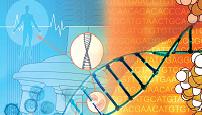Simplifying Synthetic Life
A follow-up to the post about synthetic biology...An article in Houston Chronicle describes the changes to the science.

A Life Engineering Symposium begins today at University of California San Francisco hosted by qb3 California Institute for Quantitative Biomedical Research.
Reader Chris H has pointed out how easily this science could develop into biological artifacturing.
Once the process is perfected then the invention of new life will be a matter of coming up with with the idea for the design of a new creature. The work will be in the design and software side rather than in the mechanics of building the organism.

Seeking order in chaos of genetic engineering
Synthetic biology is expanding as fears grow of potential misuse
By PAUL ELIAS
Associated Press
They're mixing, matching and stacking DNA's chemical components like microscopic Legos in an effort to make biologically based computers, medicines and alternative energy sources. The rapidly expanding field is confounding the taxonomists' centuries-old system of classifying species and raising concerns about the technology's potential for misuse.
So a new breed of biologists is attempting to bring order to the hit-and-miss chaos of genetic engineering by bringing to biotechnology the same engineering strategies used to build computers and bridges.
The idea is to separate cells into their fundamental components and then rebuild new organisms, a much more complex way of genetic engineering.
Already, synthetic biologists have created a polio virus and another smaller virus by stitching together individual genes purchased from biotechnology companies.
In Israel, scientists have created the world's smallest computer by engineering DNA to carry out math functions.
J. Craig Venter, a scientist who mapped the human genome, announced last month that he intends to string together genes to create from scratch novel organisms that can produce alternative fuels such as hydrogen and ethanol.
"We're building parts that can be assembled into devices and devices that can be turned into systems," said Jay Keasling, head of the Lawrence Berkeley National Laboratory's Berkeley synthetic biology department, which was created last year.
Keasling, who doubles as a chemical engineering professor at the University of California, Berkeley, hopes to create never-before-seen living molecules by fusing genes from the three species — a new breed of bacteria capable of spitting out malaria-fighting artemisinin, a chemical now found only in small traces in the wormwood plant.
But national security experts and even synthetic biologists themselves fret that rogue scientists or "biohackers" could create new biological weapons — like deadly viruses that lack natural foes. They also worry about innocent mistakes — organisms that could potentially create havoc if allowed to reproduce outside the lab.
complete article at...
HoustonChronicle.com - Seeking order in chaos of genetic engineering



4 Comments:
1.
How about an oyster that sucks gold atoms out of the ocean water and deposits them in its shell. Later you grind up the shells and extract the gold. You get rich AND eat all the oysters you want. By the way this is my idea- don't try to steal it Craig Venter!
2.
The blogger mentioned something the other day about Ice 9 from a Kurt Vonnegut book. As I recall, Ice 9 was a chemical compound that instantly turned all the water on Earth irrevocably into ice. Somebody let this out and wrecked the Earth. Creating an organism to make hydrogen reminded me of this. I picture a scientist creating bacteria that eat water and spit out hydrogen and oxygen. "Yippee", he says and then realizes the thing is repoducing and eating every drop of water on the planet.
3. I like Craig Venter's idea of creating organisms that produce fuel or energy or whatever. Maybe it's time to buy CRA stock again. Alternative energy is hot. He should be playing that up.
Interesting. Note that the breakthrough was made using BIOTECHNOLOGY. Fantastic. By the way, it's not too late to start building a bomb-shelter....
OOOPs I forgot to post the link-
http://news.yahoo.com/news?tmpl=story&u=/nm/20050830/ts_nm/nuclear_iran_breakthrough_dc_1
Hmmm that didn't work. I'm having trouble posting the link.
Here is the date and title. It's on Rueters.
Iran says has made new atomic breakthrough
Tue Aug 30, 2005 6:44 AM ET
Post a Comment
<< Home